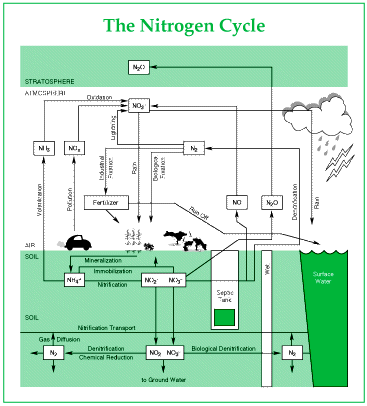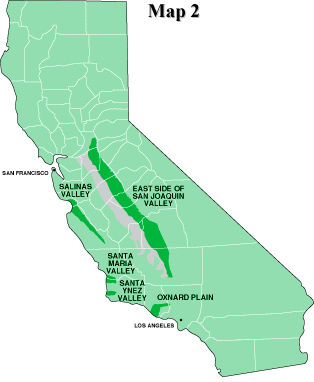About Fertilizer
Feed, Fertilizer and Livestock Drugs Regulatory Services

The Nature of the Nitrate Problem

In recent decades, environmental monitoring has revealed widespread and steadily increasing amounts of nitrate in California's vast underground water resource. The trend is associated with a growing population and with more intensive agriculture. Rising nitrate levels in groundwater are known to result from (1) manure generated by concentrated animal production; (2) fertilizer applied to crops and landscapes; (3) septic systems and sewage treatment plants; and (4) fuel combustion and industrial sources. All of these human activities produce nitrate, which is a soluble compound of nitrogen and oxygen. Nitrate also comes from natural sources – sediments and rocks, and biofixation of nitrogen by plants and lightning. Nitrate can move with water down through the soil to enter the groundwater supply. Although nitrate is a natural component of living systems, too much nitrate can cause problems for human health and for the environment. One well–known potential threat is the relationship between high nitrate levels in drinking water and a rare infant disease called methemoglobinemia (blue–baby syndrome). In the stomachs of very young babies that have not yet developed normal acidity, nitrate can change to a related compound (nitrite) that interferes with the blood's oxygen–carrying capacity.
Cancer and birth defects also have been the subject of concern in relation to high nitrate drinking water, but no firm link has been established.
The current public health standard for acceptable drinking water in California is 45 milligrams/liter (45 parts per million) of nitrate. As shown on map 1, hundreds of wells in various areas of the state currently exceed this level.
There also is an economic dimension to the problem. When nitrate in a public water supply reaches or exceeds the 45 mg/l standard, costly measures are required. The well may have to be deepened or closed down, a different water source may have to be acquired for blending, or expensive water treatment may be required. For example, the Orange County Water District has estimated that wellhead nitrate treatment costs about $375 per million gallons. In 1986, public water systems in California applied to the State Department of Health Services for more than $48 million to correct nitrate violations. The total cost undoubtedly was even larger since many water agencies used other sources of funds to address the problem.
Excess nitrogen can also cause other economic and environmental problems such as oxygen–depleting algae growth in rivers and lakes, toxicity to aquatic life, increased calf abortion rates, and even loss of quality in fruit and other crops. These are often the result of inadequate manure, irrigation and fertilizer management.
Additional costs of nitrate in groundwater include land use restrictions, denial of loans for lack of a suitable water supply, and a reduced tax base. So the problem of increased nitrate levels in California's groundwater is both significant and persistent.
Criteria for Nitrate–Sensitive Areas

The first step in implementing these recommendations was to decide which locations in the state should be given highest priority. Two conditions indicate an urgent problem: First, a high level of nitrate contamination in groundwater and, second, a population that depends on that water for drinking.
Those two conditions depend on various factors. University of California soil scientists originally listed five criteria for nitrate–sensitivity of an area:
Groundwater Use
Nitrate concentration is critical if groundwater is used for domestic or animal drinking supplies. If it is used only for cleaning, cooling or irrigation of most crops, there is less concern.
Soil Type
Sandy or other coarse–textured soils transmit water downward more rapidly, and nitrate with it. Also, these soils are less likely to create conditions in which nitrate turns to a gas and escapes from the soil (denitrification).
Irrigation Practices
Inefficient irrigation systems that lead to large volumes of subsurface drainage increase the leaching of nitrates. Typically, these are surface flow systems with long irrigation runs. Well–managed sprinkler or drip systems, or surface flow systems with short runs, reduce the threat of nitrate leaching to groundwater.
Type of Crop
Crops most likely to increase nitrate leaching are those that (1) need heavy nitrogen fertilization and frequent irrigation, (2) have high economic value, so the cost of fertilizer is relatively small compared to revenue produced (3) are not harmed by excess nitrogen and (4) tend to take up a smaller fraction of the nitrogen applied. Many vegetable, fruit, nut and nursery crops fit these criteria, and therefore have more potential for nitrate leaching. Those with less potential include field crops such as alfalfa, wheat and sugar beets.
Climate
High total rainfall, concentrated heavy rains and mild temperatures lead to more leaching of nitrates.
Two more criteria for nitrate–sensitivity were developed by FREP:
Distance From the Root Zone to Groundwater
Less distance means a more immediate problem.Potential Impact
This depends on such factors as population density and availability of an alternate water supply.
These seven factors –– groundwater use, soil and crop type, irrigation practices, climate, distance to groundwater, and potential impact––indicate the nitrate–sensitivity of an area. They determined where FREP's initial field activities were directed. In general, two regions of the state, the Central Coast valleys and parts of the east side of the Central Valley, fit the above criteria (see Map 2).
The Central Coast valleys are major vegetable producing areas. In this region irrigated vegetable fields are a potential source of groundwater contamination. The five major crops are lettuce, broccoli, cauliflower, celery and strawberries. These crops account for 41% of the vegetable acreage in California excluding processing tomatoes (see Chart 1).
On the east side of the Central Valley, tree fruits and nuts are major crops, including almonds, walnuts, peaches and nectarines, plums and prunes, and citrus. These crops account for 77% of the total state fruit acreage (see Chart 2).
(The Los Angeles basin and surrounding areas where well measurements also indicate a groundwater nitrate problem are no longer a significant farming region. For that reason, FREP's agriculturally oriented program is not active there.)

